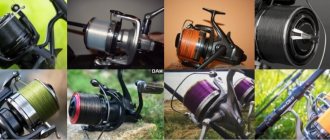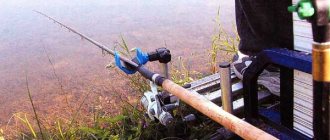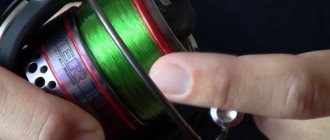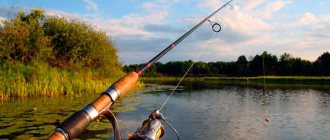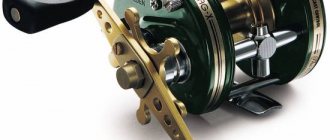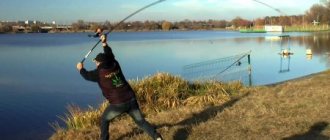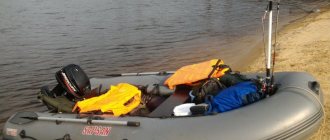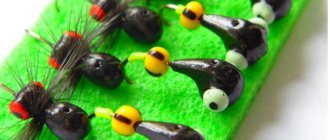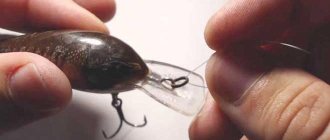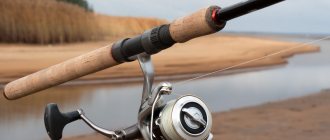Leash
The use of a protective leash is only necessary in one case: if you do not exclude the possibility of catching a pike.
Other representatives of the predatory ichthyofauna do not bite the fishing line. Many anglers prefer to do without leashes, believing that their presence negatively affects the animation of the bait. But for a beginner who does not yet have a narrow specialization and experience, it is better to use them. Leashes are:
- Fluorocarbon. They are usually made independently, but recently ready-made leashes made from fluorocarbon fishing line have appeared on sale. Unfortunately, they are powerless against the teeth of seasoned pike, but they have another advantage: fluorocarbon is almost invisible in the water, which is ideal when catching passive fish.
- Metal. The material for such leashes is thin steel wire (like a guitar string). A pike is guaranteed not to bite through a metal leash, but will bend it instantly. It is unlikely that it will be possible to straighten it perfectly, so you need to have a fair supply of these equipment elements - a deformed leash is not suitable for fishing.
- Metal in nylon. A metal leash placed in a nylon braid costs a little more, but does not bend as much. Perhaps it can be called the best option for a beginner.
- Titanium. A very durable and at the same time plastic material that is practically not subject to deformation. It has only one serious drawback - the high price.
How to cast a spinning rod correctly: casting methods
First, you need to understand how a spinning rod is cast in general and how it can be cast, depending on the fishing conditions. After all, fishing conditions can be different, depending on the body of water. This could be a body of water with clear banks or a body of water where thickets make it difficult to approach clean water. In addition, thickets are possible in the water, which requires very precise casting. Based on real conditions, it is possible to use the following spinning casting options:
- Vertical.
- Horizontal.
- Pendulum.
- Ejection.
And now, in more detail about the technique of each cast.
Vertical cast
It is used almost always if nothing on the shore interferes. This is a very easy to learn and effective casting method that allows you to deliver the bait exactly to the designated location.
Vertical casting over the head is the main option for casting spinning lures. To carry it out, you need to find a point on the surface of the water where the bait is supposed to be delivered. Using a reel, the line is reeled in so that the bait is 20 cm from the tip of the rod. After this, the line arc opens and the line is pressed with the index finger to the rod blank.
Horizontal (side) cast
This casting technique is very effective on small rivers, where long-distance casting is completely useless, but precise casting is just right. In this case, the bait flies above the surface of the water and hits exactly the place that is located under the branches of trees hanging over the water.
The only drawback of this throwing technique is the need for long training. It will not be possible to cast the bait accurately and correctly the first time. If you master this technique perfectly, you can safely consider yourself a master of spinning fishing.
How to perform the horizontal casting technique
The casting technique is the same, only the spinning rod is not retracted behind the back, as in the first case (with vertical casting), but to the side, either to the left or to the right. As in the first case, first you need to decide on the casting direction and the bait delivery point. The accuracy of casting depends on the moment when the line is released from the clamp. In the process of horizontal casting, a clear reaction is required for timely release of the line, which is only possible after long training.
Pendulum and catapult casting
Pendulum and catapult casting are used very rarely due to the complexity of its implementation and difficult fishing conditions. This can happen if there are significant thickets on the shore, and the place is very promising. But before that, you should think about how you will subsequently be able to pull the bait out of the water, and even more so with a trophy.
How to perform a pendulum cast
You need to pull the bait to the tip of the rod, lower the line handle and grab the line with your finger. After this, the bait seems to swing and with a sharp movement from under itself is directed to the desired point. The main thing is not to forget to remove your finger from the fishing line in time.
This technique will not allow you to cast the bait far, but this is not required, since the main task is to send the bait exactly to the designated place, although not far from the shore.
How to make a catapult cast
The difficulty of casting lies in the fact that you need to pull the bait with one hand, pulling the line, and with the other hand hold the rod and fix the line. Without certain skills, such casts are quite difficult to perform.
It is believed that this is the simplest, but at the same time accurate type of casting. It is suitable for clean, spacious reservoirs, without vegetation in the fishing area. This is done as follows:
Parameters of long-range spinning rods
The ability to make long casts requires a harmonious combination of all components of spinning tackle. This includes an appropriate reel, a suitable fishing line, and a bait that meets the test characteristics of the blank. But, of course, the most important link is the spinning rod itself. It is its parameters that primarily determine the possibility of long-distance casting. When choosing a long-range fishing rod, the following characteristics are primarily important:
- Length.
- Build.
- Passing rings.
The technique of casting the bait is also very important. If casting is performed incorrectly, even the longest-range spinning rod will not be able to provide the required range.
Length
The possible casting distance directly depends on the length of the blank. This parameter is considered the main one for a spinning rod that is planned to be used for long casts. Short blanks should not be considered for this purpose, as they will not be able to provide a decent swing and the necessary inertial force.
The length of the spinning rod for long-distance casting should start from 2.7 meters. Such a stick, with proper experience of the fisherman, will help to cast the bait at a distance of 80 - 100 meters. This is quite enough when fishing on lakes, medium rivers and bays.
Expert opinion Knipovich Nikolai Mikhailovich Zoologist, hydrobiologist. I am interested in fishing at a professional level.
Interesting! Spinning rods designed for long-distance casting most often have a plug-in design and consist of three legs.
A rod length of 2.7 to 3.2 meters is considered optimal for making longer casts. Such spinning rods can be used on large rivers, lakes and reservoirs.
There is no need to take longer sticks, as they have quite a serious weight and will be uncomfortable during active fishing. It is advisable to take them only for sea fishing. In such conditions, it is possible to use rods up to 4.2 meters long.
Build
The rod's structure is very important for long-range spinning. As is known, whips, depending on the characteristics of their structure, are divided into three main categories:
- Fast action rods bend under load in the upper part.
- The rods are of medium action (bend in the upper half).
- Slow action rods (bend along the entire length).
Spinning rods with a slow action are considered the most suitable for long-distance casting. Due to the bending of their entire body, they create sufficient inertia and throw out the bait themselves, like a good spring. But their disadvantage is that they are not sensitive enough, and it is difficult to make a quick, timely hook with them. All work with such whips is carried out with a large amplitude, which is not always convenient.
Medium action spinning rods also allow you to make long throws, but without the angler having some experience, this will be somewhat more difficult to do. But they are quite sensitive and allow you to make fairly quick hooks.
To cast long distances with a fast action rod, the angler must confidently master a certain technique. A beginner will not be able to cast bait far with such a spinning rod; they are rigid and will not be able to provide sufficient inertial force. But the advantage of these whips is their sensitivity and the ability to make an instant hook. Therefore, such spinning rods are the choice of professionals.
Passing rings
The size, quantity, location and quality of the spinning rings also has a serious impact on the possible flight range of the bait. Their main function when casting is to guide the cord (line) from the reel to the tulip and hold it.
In this case, the friction force of the fishing line on the inner surface of the rings plays a serious role in the casting process. At first glance, this factor may seem insignificant, but given the speed of movement of the cord and the fact that there can be up to 7 - 9 units of guide rings, it becomes clear that the resistance to the movement of the bait created due to the friction force can be significant and long-distance casting with a spinning rod will be complicated
It is also very important to ensure the precise alignment of the rings. They must be strictly on the same line
The basic requirements for the guide rings of such fishing rods are:
- Significant diameter, especially at the initial rings located closer to the coil.
- Internal inserts made of hard and smooth material, such as carbon or titanium.
- High quality fastening. They must be integral with the body of the form.
The number of rings is also an important parameter. There should be no more of them than is required to evenly distribute the load on the rod when playing fish.
Criteria for choosing a long-range spinning rod
As when choosing any other fishing rod, you need to pay attention to the main parameters that depend on the intended type of fishing and type of fish, and determine the accuracy and casting range. These characteristics include:
- the length of the blank, on which the swing properties of the rod and the flight range of the bait generally depend;
- action, a very important parameter that allows you to select a rod for a specific type of fishing and on which depends how well the wiring will be felt, as well as the notching;
- the material of the rings and their configuration are very important elements of the spinning blank, since they determine how long the fishing line will last, as well as the extent to which the load will be evenly distributed along the rod;
- The rod test tells you how much bait can be used for effective and, importantly, safe casting.
Any mistake in the selection of these characteristics will inevitably lead to a negative result or, even worse, to negative consequences. Thus, an incorrectly selected length will not allow you to cast the required distance or will provide constant hooks on coastal bushes. An incorrect structure will not allow the bait to be given the necessary plausibility of the game that will seduce the predator; rather, it will detect the deception and move even further from the shore.
We recommend reading: All about attractants for fishing: application, effect, DIY preparation
The quality of the rings will affect the wear of the cord, which at one point will lead to its breakage during casting or retrieving, providing the angler with the loss of both the bait and the trophy. Since the rod is still a fly tool, the test must be selected with a tolerance from the specified interval, usually this is plus three grams from the lower limit and minus 3 grams from the upper limit. Thus, the 7-21 gram test is optimal for casting baits weighing 10-18 grams.
It can be seen that the distinctive feature that makes the main contribution to the casting distance is the length of the blank. This is explained by the fact that the moment and the force transmitted to the cast, and, consequently, the impulse of the bait are directly proportional to the length of the arm. It is classically believed that long-range fishing rods have a length of over 3 meters, but both the structure and the skills of the fisherman contribute here, so there are cases when spinning rods of 2.7 meters showed the best result in terms of bait delivery range.
One feature that should be mentioned here is the uncertainty in the choice of form structure. The longest cast can be made using a slow, parabolic action, in which the entire length of the rod is working. However, such a system responds very “sluggishly” to bites and is uninformative when guiding, not allowing you to achieve the desired game.
Therefore, anglers prefer medium or fast-medium action, which provides good hooking and sensitivity, although it requires certain skills to ensure long casting.
To summarize, we can say that before choosing a spinning rod for long-distance casting from the shore, you need to carefully familiarize yourself with the features of the reservoir, its topography and coastline. As well as the habits and type of intended prey, on which the choice of catchable bait and, consequently, the parameters of the fishing rod used depend.
Which spinning rod is better to choose?
First, decide how and where you plan to hunt and what kind of fish. For the first time, a spinning rod with average values is suitable.
Fishing conditions
Before purchasing a fishing rod, first decide on the fishing conditions. How are you going to hunt: from a boat, shore, cliff or mountain river, etc.
To make the explanations more clear, I will give an example: we found a promising place, but it is located in a thicket of trees. There is only one way out - to make short but sharp wrist casts with a non-flexible blank, fast action. In open areas it can be easily swung. Therefore, it is more advisable to use a slow or medium tuning here.
Loot Selection
Also be sure to decide on your choice of prey in advance. What fish are you going to hunt and what bait to use.
Test - should show the weight of the bait. The upper limit is the maximum permissible weight, the lower limit is the minimum weight. Example: test 2-7 g. will mean one thing, the form can only work with light baits.
This is unacceptable for jigs, wobblers, jerkbaits. But for “turntables” and “oscillators”, this is a normal option. With a fast blank, only the upper third will bend under load. Medium action - has versatility, length - 1.9 to 3.2 m.
When purchasing, make sure there are no defects. Inspect everything carefully: is it well finished, what kind of assembly is it, the quality of the rings, how the varnish is applied. Are there any scratches, chips, or any defects? If necessary, ask the seller questions without hesitation.
The handle is now often made of cork and neoprene. There are more expensive options, but this is irrelevant. A warmer handle is made from cork and has a different shape.
You need to take the rod in your hand and hold it, you should feel whether it is comfortable for you or not. Inspect the tight fit of the handle to the form. There may be defects during production: the material may not be glued well, there may be visible damage. These defects will lead to rapid breakage of the handle.
Reel seat - there are different designs, so not every reel can be attached to it. It’s worth going to the store to grab it and try it on.
More than 50 manufacturers are known in Russia, here are some of them:
- Aiko - price up to 400 USD
- Maver Canna Eroica MX - about 300 USD
- BlackHole - the average price is no more than 100 USD, but the price of some models reaches 300 USD.
- Daiwa - the cost reaches 200 USD.
- G.Loomis - some copies cost 400 USD.
- Graphiteleader - the upper price limit reaches 350 USD.
- Mikado - the ceiling reaches 450 USD.
- Shimano - average cost, up to 80 USD
Fishing technique
When casting, you should strictly adhere to simple rules that will protect the fisherman and his neighbors from injury:
Long-distance casting with a spinning rod is carried out with sweeping movements, which can easily hit someone standing next to you. The impact may not be strong, but the effect of surprise will play a big role in this
If you are not careful when casting, you can catch your neighbor on the hooks. If the snag happened only on clothing, we can say that you are lucky
Beginner fishermen very often catch themselves, and the hooks cling not only to clothes. Puncture wounds are often inflicted with hooks, and sometimes such fishermen end up in the surgical wards of hospitals.
It follows from this that you should maintain a certain distance and not stand too close to the spinner, especially while casting. It's better to take a walk along the shore and get some fresh air.
The most popular is the simple casting method, which is carried out “from behind the ear”. To do this, the rod is simply brought back, before this the spoon is slightly lowered, the spinning reel bracket is thrown away and the cord or line is lightly held.
At the moment of casting, the line is released, thereby allowing it to be reeled out freely.
At the moment of casting, the rod should be at an angle of 45 degrees relative to the shore.
When choosing a fishing spot on a new, unexplored body of water, you should initially determine the depth and the presence of irregularities on the bottom. After all, large trophy fish choose depth differences for their habitat.
To take measurements, it is recommended to use an additional weight on the hook. Later it is removed as unnecessary. To determine the most advantageous casting distance, after finding the required depth, you should put a mark on the fishing line near the tip of the fishing rod.
Having chosen the desired fishing spot, you should feed the fish, using at least 50% of the prepared mixture.
How are they different from spinning?
The difference in the spinning rods themselves is great. It largely depends on the fishing method and the type of fish that the hunter wants to catch. Moreover, the types of spinning rods used vary greatly from region to region. So, in the north you cannot do without a powerful whip, since the fish caught there are usually large in size.
But further south, in coastal areas with rich aquatic vegetation, completely different rods are used. For example, carp fishing requires completely different characteristics that should be inherent in the form. In other words, there are no universal fishing rods. Therefore, the differences between one type of spinning rod and another, and even more so from a long-casting rod, are a completely justified feature determined by fishing practice.
The defining feature of these differences is the purpose of fishing - the fish and its size. Spinning tackle is used for hunting predatory and large fish using artificial bait. Therefore, the length of the whip of such rods usually remains in the range of 1.8-3.3 m. The test and structure of such a rod completely depends on the fishing method. Thus, a trolling rod is usually of short length, but with a high test - you need to hold a large fish.
If we talk about peaceful fish, then the differences between a spinning rod and a long-casting rod become concrete and obvious. In addition, even a standard float fishing rod is divided into a number of categories.
Thus, fly fishing rods are used for fishing near the shore. Often they are not even equipped with pass rings and reels.
For long-distance casts, match and plug rods are used, equipped with a significant number of guide rings located on special stands to prevent the line from sticking to the body of the rod. They are made about 5 meters long for long-distance casting performance.
Thus, despite all the similarity of the equipment elements of the spinning rod and the fishing rod, the latter is longer, equipped with a reel seat and many guide rings on stands. At the same time, you need to understand that fishing with a fishing rod is more passive, because the main task of the angler is to wait motionless and watch for the bite signal.
Long-distance casting gear layout
Above we looked at how to choose a spinning rod for long-distance casting. When assembling long-range gear, other elements are also important:
- Coil.
- Fishing line.
- Bait.
In most cases, anglers use a spinning reel. It is worth noting that with a multiplier, with the correct technique and a properly adjusted clutch, the casting of the same bait will be further. However, this does not apply to situations where you need to assemble a spinning rod for casting light baits.
The unskilled fisherman must lay the cord on the spool efficiently. If it lies flat without dips or humps, then a decent casting distance is guaranteed. Otherwise, the reel will throw loops, create overlaps and form beards.
We pay special attention to the side of the spool. It should be perfectly even and smooth, without defects. Chips and unevenness will shorten the casting range of the bait and spoil the fishing line, which will subsequently lead to an unexpected break at the most inopportune moment during fishing.
The thinner the cord or monofilament, the further the bait will fly. It is important to compare the weight of the spoon and the breaking load of the fishing line, so as not to break it during a power cast. It is better to give preference to braid with a smooth structure or put nylon on a spinning rod; then the casting range will be maximum.
It is impossible to make long casts using floating bulk baits for spinning rods, since in the air they provide strong resistance, which conceals precious flight meters. Without a suitable set in your fishing box, you shouldn’t go out onto a large body of water. A good-quality spinning rod for casting without a compact, far-flying spinner will not help.
The best lures for long-distance fishing are narrow-bodied jig-class oscillating spoons. They have no equal in terms of flight range. Unfortunately, these spoons are not always suitable for fishing conditions and potential catch.
Technique: casting, retrieving, retrieving
The behavior of a marine predator, just like a freshwater predator, is closely related to seasonal climate changes. Also, the activity of sea fish varies greatly during the day. As a rule, sea fish feed most actively in the warm season and in the fall, before cold weather.
As for the time of day, the greatest activity should be expected at morning and evening dawns.
A fertile time for fishing from the shore is the night, when a marine predator emerges from the depths onto the coastal shallows in search of food. However, these general recommendations are very conditional, since the behavior of fish in different seas - southern and northern, deep and shallow - is very different.
Therefore, it is always better to make inquiries in advance about the water area where you plan to fish in order to know what you need to be prepared for. On the Black Sea, night fishing with a light spinning rod for bottom predators in the coastal strip has become extremely popular.
Silicone baits are used on weight heads, which are carried with standard jig wiring, and wobblers. The main trophies are scorpion fish, bison and croaker, and if the weight of the former often does not exceed 100 g, then a croaker caught on a hook can weigh more than 5 kg, and this is already a very serious rival, the fishing of which will most likely be remembered for a lifetime. When fishing with a spinning rod at sea, the same techniques are used as in freshwater fishing.
Casting
A feature of sea fishing is the frequent need to make long casts (if fishing occurs from the shore) and strong winds, which are often present at sea. In this situation, sharp power casts are required, which, provided that long rods and heavy baits are used, can “break through” even a hurricane wind, sending the bait over a distance of several tens of meters.
Wiring
When catching bottom predators in the coastal zone with a jig, a standard step-by-step retrieve is used, familiar to all spinning anglers from fishing in freshwater bodies: after casting, the bait must be allowed to sink to the bottom, after which several turns of the reel handle are made, then a pause, during which the bait falls to the bottom again , then the reel handle rotates again.
When fishing with cranks, the wobbler can be driven evenly, while the bait will go along the bottom, digging the soil with a spatula and fighting off stones.
Stop and go wiring is also suitable: after casting, you need to deepen the bait to the bottom, then wait a short pause, during which the wobbler rises slightly from the bottom. This is followed by several turns of the reel handle, after which the bait again hits the bottom with a spatula, then again there is a short pause.
When fishing with oscillating spoons and jigs in the water column, near the surface or near the bottom, mostly uniform fishing is used. But when catching large and strong fish far from the shore, slow retrieval of the bait is unacceptable: these sea predators respond primarily to fast and sharp retrieves.
Choosing a spinning rod for long casting
The maximum distance to which you can throw the bait depends on a well-chosen fishing rod. The right spinning rod for long-distance casting from the shore determines the success of fishing in large bodies of water.
The main parameters that you need to pay priority attention to are:
- Length.
- Build.
- Rings.
- Test.
The growth of a fishing rod is a basic parameter that directly affects its sending power. Without going into too much detail, long spinning rods throw much further than short ones. There is nothing surprising here: a longer arm creates more torque and force when casting, which allows you to give the bait greater acceleration. A tall stick sets the required flight path, which also affects the casting distance.
In general, fishing rods with a length of 3 meters and above are usually called long-range. However, this is not an axiom. Today on the market there are rod models with a length of 2.70 meters and even less, capable of competing in terms of range. Therefore, when deciding what length of spinning rod is best for long-distance casting, you need to find out the experience of experienced fishermen, search for information online on thematic resources and, if possible, test the rod before purchasing on a pond or at least at the nearest stadium.
The formation has a significant impact on the casting distance of the bait. Slow sticks or “parabolics” are capable of sending the lure over the longest distance, since they allow you to develop impressive force and work like a sling.
However, in many cases, such a system will not be suitable, since slow spinning rods lack the sensitivity necessary to detect predator bites and the rigidity to perform biting, confident hooks. In this case, anglers are forced to make a choice in favor of fast or medium-fast fishing rods. True, mastering the correct long-casting technique with them is much more difficult.
During the flight, the line rubs against the rod guides. Therefore, how far the bait can be sent depends on their quality, quantity, diameter and location. Often the first ring of a large radius indicates the impressive range of the spinning rod. You should pay attention to the material of the inserts and the quality of their execution.
The rod test can be considered a secondary parameter when choosing a long-range stick. Naturally, a heavy bait can be cast further, but you often need small spinners that weigh a little. How to be in this case?
Spinning rods for long-distance casting of light baits should be selected in the same way as in other cases. You need to understand that the maximum casting distance is achieved with baits weighing close to the upper limit of the rod's test. For example, to use spinners of 10–12 grams, a fishing rod with a dough of up to 15 grams would be optimal. It is not recommended to overload the stick, otherwise it can be broken during a power throw.
How to equip a spinning rod correctly
For fishing to be successful, you need to know how to assemble a spinning rod with your own hands. Any spinning tackle consists of several elements: a spinning rod, a reel, a fishing line and an artificial ultralight bait.
In addition to the basic elements, there are several details that can improve the tackle. Before you start fishing, you need to prepare your rod. For beginners, it is necessary not to make mistakes in the technology of assembling a spinning rod. You need to know about the parts intended for the fishing rod and how to assemble the spinning rod.
- Characteristics and components of a spinning rod required for equipment
- Assembling the rod
- Types of baits for spinning fishing
- Types of equipment
- Equipment with baits
How to assemble a spinning rod correctly and equip it with your own hands? When assembling a fishing rod, it is necessary to take into account several requirements that relate to the characteristics and configuration of the spinning rod.
The fishing rod must meet the following requirements:
- The test load should be from 12 to 15 g. If the weight of the bait is small, then an acceptable test is 8-10 g.
- The length of the spinning rod for fishing from the shore should be 2-2.5 meters, and when fishing from a boat it should be 1.5 meters.
- The rod must have a rigid tip.
- You should choose a sensitive rod to hook fish in a timely manner.
- The spinning rod's action is average. Suitable for any fishing conditions.
- Coil. In spinning fishing, multiplier and spinning reels are used. The former have low sensitivity, and the cast is close, so it is better to use inertialess ones. A good reel has a little play inside and a high-quality line guide attachment. Spool sizes range from two and a half to thirty-five thousand. The number of bearings is unlimited. The reel spins well with a small number of bearings. The capacity of the reel is from fifty to eighty meters.
- Fishing line. Anglers who use spinning rods to catch fish opt for monofilament and braided fishing line. Professionals recommend choosing braided fishing line because it can withstand heavy loads, does not tear, retains its shape, and is highly sensitive to bites. A fisherman can use braid on lead rigs for spinning rods more than once. The optimal diameter of the fishing line is 0.12-0.15 mm.
- Lures. For spinning fishing, spoons, wobblers, spinnerbaits and jig baits are mainly used.
Assembling the rod
Reel mount
Any version of the spinning rod has space for a reel.
You can connect the coil as follows:
- unscrew the bottom nut. You need to twist it until the reel holder is completely in its proper place;
- tighten the nut. The nut must be tightened tightly, but carefully so that the thread is not stripped.
The reel is ready for use.
Before fishing, it is necessary to adjust the friction brake. It is responsible for protecting the coil from overloads.
The setup is as follows:
- the end of the fishing line is secured to the base and moved some distance away from it;
- after the clutch is fully tightened, begin to tighten the fishing line;
- After tensioning, lower the clutch until the reel releases the fishing line.
Connection of leash and fishing line
A leash is a part of a fishing rod designed for fishing for predatory fish. There are fine, semi-rigid and hard leashes. Any species is configured to fish out different predators.
To connect the fishing line and leash, you must follow the instructions:
- A fishing line is inserted into the eye of the swivel.
- The eyelet rotates eight times around its axis.
- The end of the line goes into the loop.
- The line is tied into a knot and its end is cut off.
Winding fishing line onto a reel
When is long casting necessary?
Long casting is needed for shore fishing. When fishing from a boat, you can always swim up to a promising place and explore it from different angles, using a variety of baits. From the shore, the spinning angler is deprived of this opportunity, so there is a need for a sending rod.
When fishing on a small river, where the bait needs to be cast a maximum of 50 meters and this situation rarely arises, they try to make the tackle as light as possible. This allows you to fish with light weight lures, performing delicate movements.
On large deep rivers you can count on a good catch only when the spinning rod allows you to “cover” significant distances. Promising points are not always located close to the coast. Often you have to send the bait 100 meters or further. This way you can catch the following areas:
- Channel edges and other bottom irregularities.
- Deep rifts and slides.
- Pits or extended ditches.
- Single submerged tree trunks or full-fledged snags located far from the shore.
In the above situations, the casting distance of a spinning rod plays a decisive role in the effectiveness of fishing. If a fisherman, due to an incorrectly selected fishing rod, was unable to reach the desired promising point, then he is deprived of a likely bite from a predator.
The importance of casting range is fully understood by asp fishermen. This cautious predatory fish, when hunting at the surface of the water, rarely allows anglers to get close to it. Only a spinning player who has long-range gear and has the correct casting technique can count on stable bites from a sheresper.
Building a spinning rod for pike
One of the important characteristics that you should pay attention to when choosing a spinning rod is its action. This indicator is associated with the bending of the form under load and indicates the distribution of flexibility and rigidity along its entire length
The action determines how far and how accurately the bait can be thrown, as well as whether the tackle will withstand the jerks of the fish when landing.
There are several types of structure:
- Very fast (type A) - only the tip of the rod bends, that is, a quarter of its length. With the ultralight action, high casting rigidity and accuracy are ensured, but its casting range is short, and shock mitigation is rather weak, which increases the load on the reel gearbox, fishing line and prey lips.
- Quick (B) - Three-quarter bend.
- Medium (half or C) - the form bends halfway.
- Slow (parabolic or type D), when almost the entire rod bends and provides the longest cast, although not very accurate. The jerks of the prey are noticeably softened, and accordingly the load on the fishing line and the reel gearbox is reduced.
The last two types of rod construction are the most popular among anglers. They have the advantages of types A and D, but without their disadvantages. Slow action is used very rarely when hunting pike, since it does not provide sharpness when fishing for a predator and does not allow you to cut through its hard mouth. There are also intermediate options:
- medium-fast;
- medium-slow.
The form structure is selected in accordance with the baits used:
- for silicone - from fast to very fast;
- for wobblers - from fast to medium-fast;
- for spinner spoons - from medium to medium-fast;
- for the vibrator - from slow to medium;
- Any popper is suitable, but for greater throwing accuracy and active play, it is better to use a fast one.
Technique for long-distance casting with a spinning rod
Mastering long casting and developing the correct technique for its execution is not easy. Any angler can learn to throw a bait 60–80 meters, but not everyone, even an experienced spinning angler, can send it 100 meters away.
Having a properly assembled long-range spinning kit and a compact bait, you can consider the intricacies of long-distance casting:
- The best option is to cast in a forceful manner from behind the head or from the side. The main casting methods are described in detail here.
- The spinning rod must be held with both hands, giving it acceleration at the final stage of the swing.
- The line release should be about 1/2 or 2/3 of the length of the rod.
- The bait should fly at an angle of 45 degrees to the horizontal.
Often anglers, especially beginners, are afraid to cast in a power style, because during the backswing there is a feeling that the blank is about to break in half. Over time, this feeling goes away and confidence in your gear appears, because long-cast spinning rods have a good margin of safety. An article on the topic: technique of casting tackle will tell you in more detail about this.
When and where to fish?
If everything is clear with the equipment or you use what you have, a novice spinner may have questions about the time and place of fishing.
Season
Weather always plays a role in fishing success. Even before entering the reservoir, you should study the behavior of future prey at different times of the year; this affects fishing tactics.
Each season has its own characteristics for fishing.
- Spring. The ice melts and the so-called “liquid water season” begins. As the water warms up, the predator becomes more active. It emerges from winter holes and looks for warmed areas of the reservoir. In the middle of spring (approximately) the flood begins, and for fishing this is the most unpromising period, the water is polluted, you can’t see anything because of the silt, so the bite actually stops. And it will intensify by the end of the season. By the end of April, in May you can already count on catching perch from the shore. Pike can also be caught, but pike perch behaves most unpredictably at this time.
- Summer. Those who catch pike from the shore don’t really like summer. The pike avoids the scorching sun, descends lower, swimming to the middle of the reservoir. That is, without a boat, getting it out of there is almost impossible. Dawn and sunset are even more or less successful hours, because the heat subsides and the sun no longer reaches the pike as much. Summer fishing for perch from a boat is also more predictable and successful than from the shore. At this time, pike perch lives at depth, in pits, and also in cold pools. For its extraction, jig rigs are used. At night, pike perch gets out into shallow coastal waters, and this is where you can waylay it.
- Autumn. Spinners are waiting for this period; they are anticipating the “autumn zhor.” Predators become active, scurrying around the pond in search of food, after all, they need to gain fat before hibernation. Both deep and surface baits perform well. Trophy fish still need to be looked for in holes, and, of course, that’s why shore fishing is not the most successful. But, in principle, in the fall the fish bite all daylight hours, which is already wonderful.
Reservoirs
Virtually any body of water is suitable for such fishing, which is its undeniable advantage. But if streams and ponds can be explored on a large scale, then full-flowing rivers and large lakes can only be explored along the banks.
Let's look at different types of reservoirs.
- Flow-through. Fishing in such waters has its own peculiarities. The water flow is weak, so it does not affect the wiring of most baits. Unless ultralight baits are used adjusted for lateral drift. On turbulent rivers, casting and retrieving are done according to the rules: if the goal is to get to a specific bottom area with a hole or riffle, you need to throw the jig head a little higher upstream.
- Non-flowing. Lakes, ponds and bays are very popular among spinners. If there is no wind, delivering the bait to the desired point on the bottom is not so difficult. They are caught using wobblers, jigs, spinnerbaits, and spoons. There is no current, so the baits can work to their full potential. It is most beneficial to use non-hooking baits, since many fish prefer to settle in algae.
Rating of spinning rods for long casting
Today, every manufacturer of spinning rods has models designed for long- and ultra-long-distance fishing. You can choose a suitable fishing rod in any price range. Below we will look at the top 5 sending sticks, which are designed for fishing from the shore at a decent distance from the angler.
№1.Norstream Kando 962H
The most “tall” model in this line of fishing rods. It's called "Power Master". Developed specifically for ultra-long casting. Allows you to work with baits in a wide weight range. Spinning rod length 2.89 meters, test 12–45 grams. Recommended for shore jigging due to its sensitivity and impressive power. Also used as an asp tool. Full review of the stick.
№2.Daiwa Whisker 1002MHS
An old well-known spinning rod model, which has excellent range and power. Its impressive weight of 20–60 grams allows you to use very heavy baits and fish in strong currents and great depths. The length of this model is 3.05 meters, so its portability is beyond doubt. A very reliable fishing rod and can be handled carelessly, therefore it is recommended for beginners. Among the disadvantages, it is worth noting its decent weight. Full review of the stick.
№3.Daiko Absolute 1002MHXF
A fishing rod from the premium segment, aimed at coastal jigging and ultra-long casting. Has a height of 3.05 meters with a test range of 10.5–42 grams. The spinning rod has high sensitivity and rigidity. Allows you to register light bites at a long distance and perform a confident hook. It “knits” the fish well and dampens its sharp jerks.
№4.Banax Thunder 100MHXF2
This series of rods has been produced since 2006. During this time it received a lot of positive feedback from fishermen. The model in question has a height of 3.05 meters, and the test weighs 10–35 grams. Throws bait far and is designed for jig fishing and asp hunting.
№5.Pontoon21 Psychogun 1072MMH SF
The tallest fishing rod in our small rating. Its length is 3.23 meters. The test is 10.5–32 grams. It has excellent feel and power reserves. Recommended for jig fishing from the shore and asp fishing at ultra-long distances. It has a complex system called Sensitive Fast. Full review of the stick.
